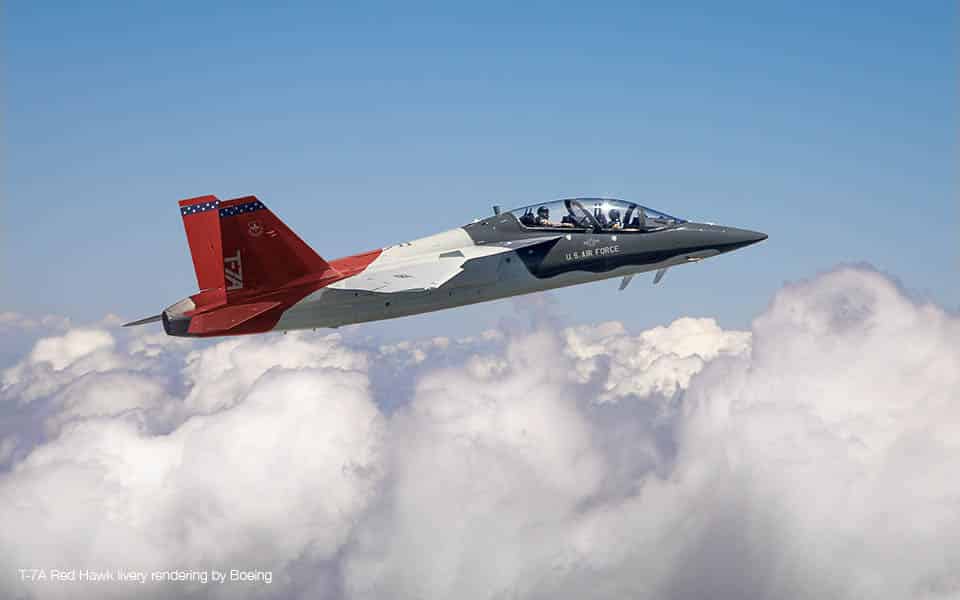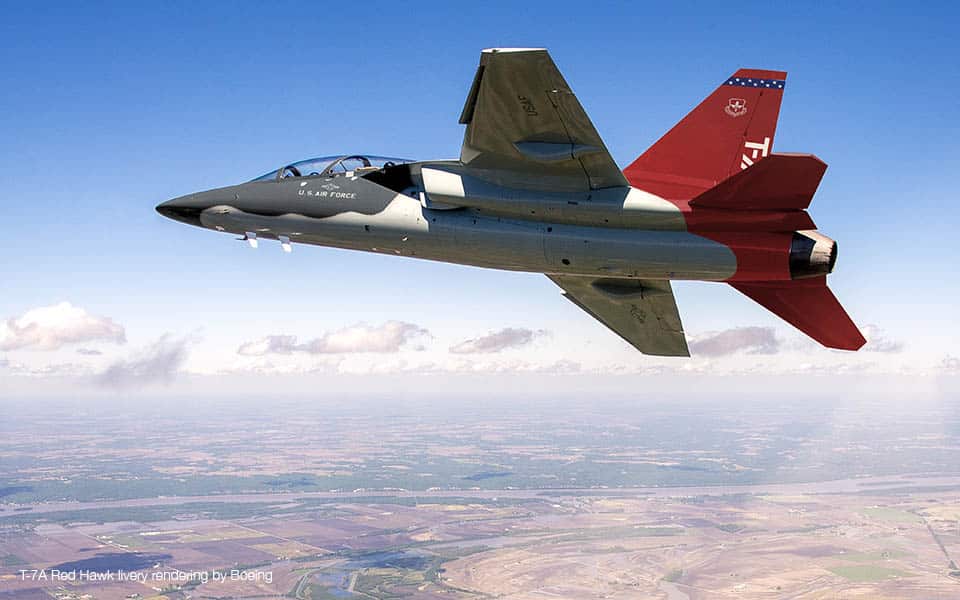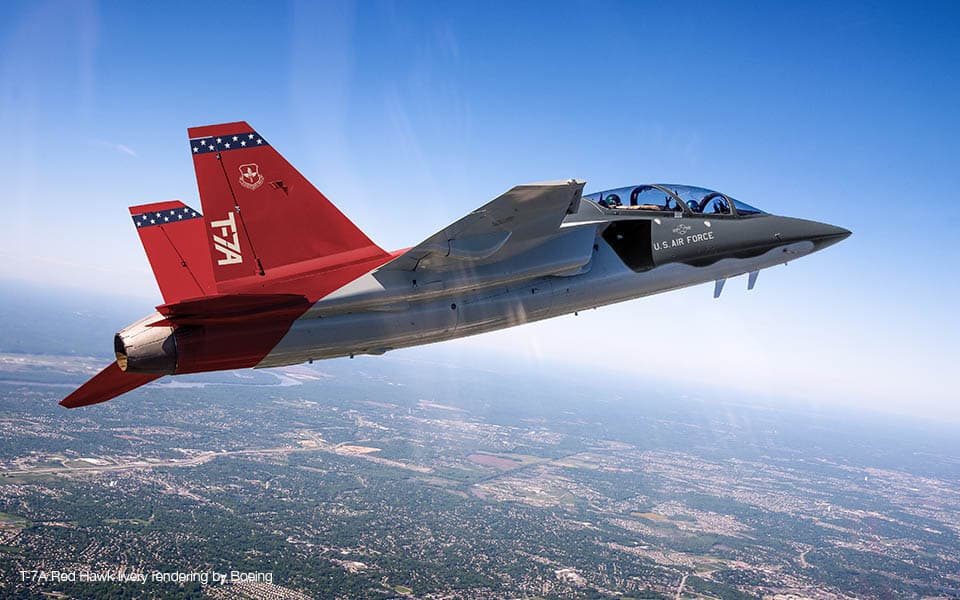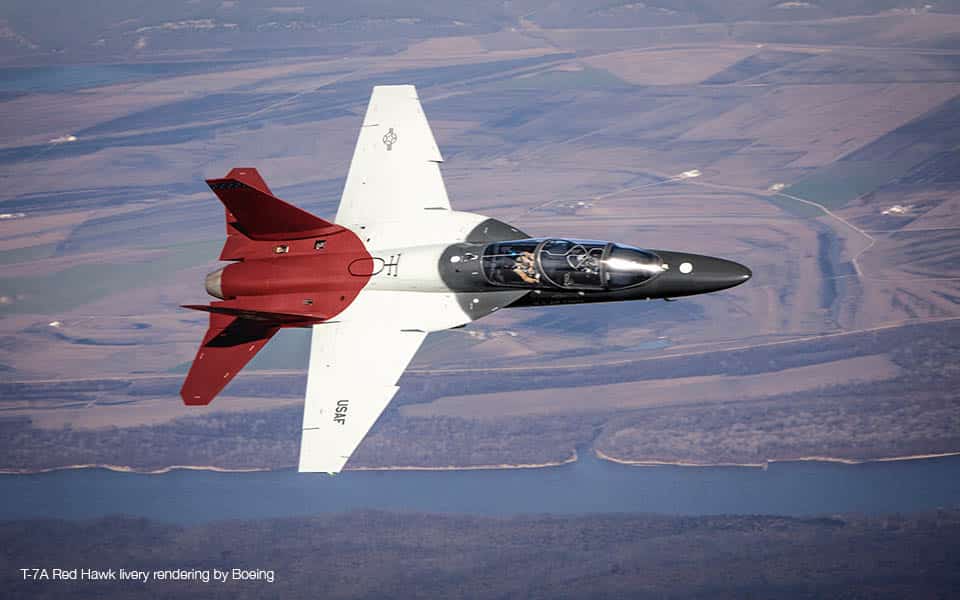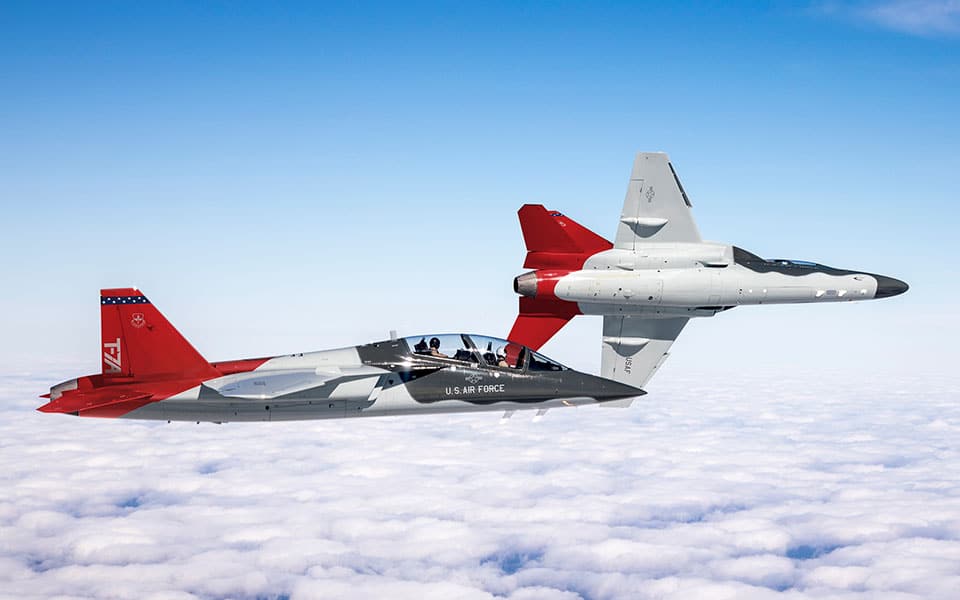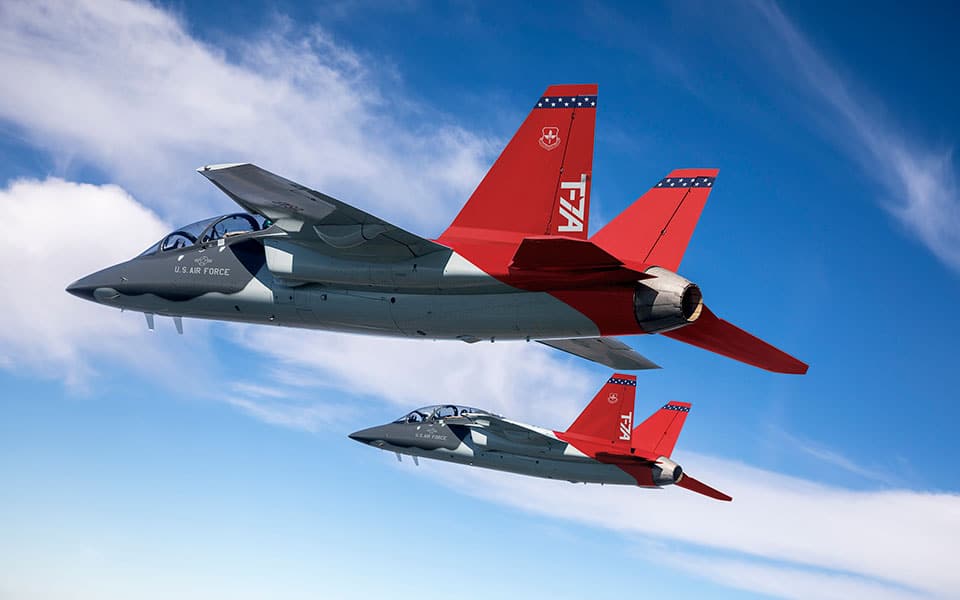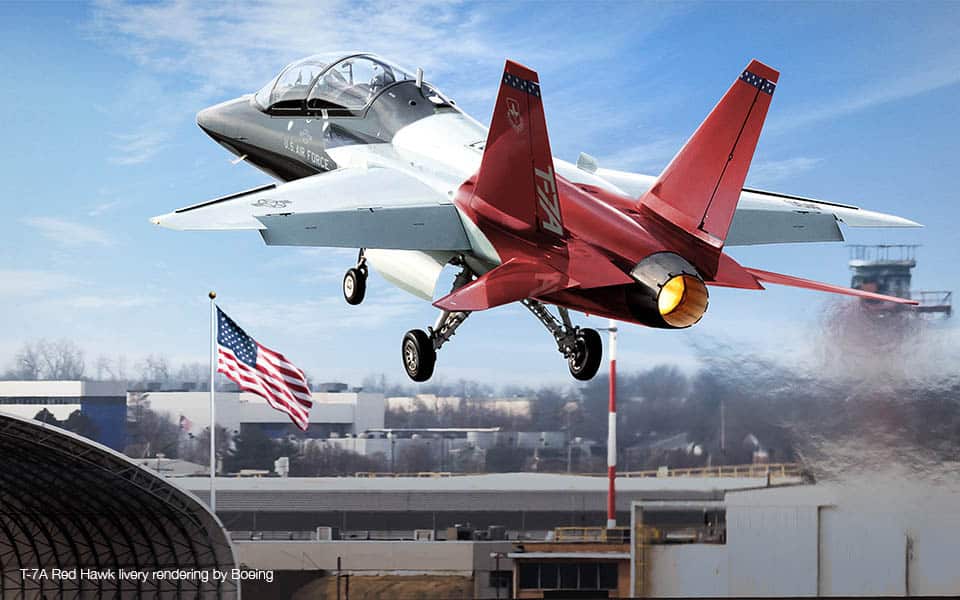Aerospace
Top 5 facts about Boeing’s T7 Red Hawk trainer aircraft

Boeing has unveiled the T7 Red Hawk, a highly anticipated aircraft created in conjunction with the Swedish business SAAB. Initially, Boeing won the proposal to replace the Northrop T38 Talon aircraft in the US Air Force’s new need. Boeing believes that with the Digital thread, aeroplanes may be maintained and designed in simple steps.
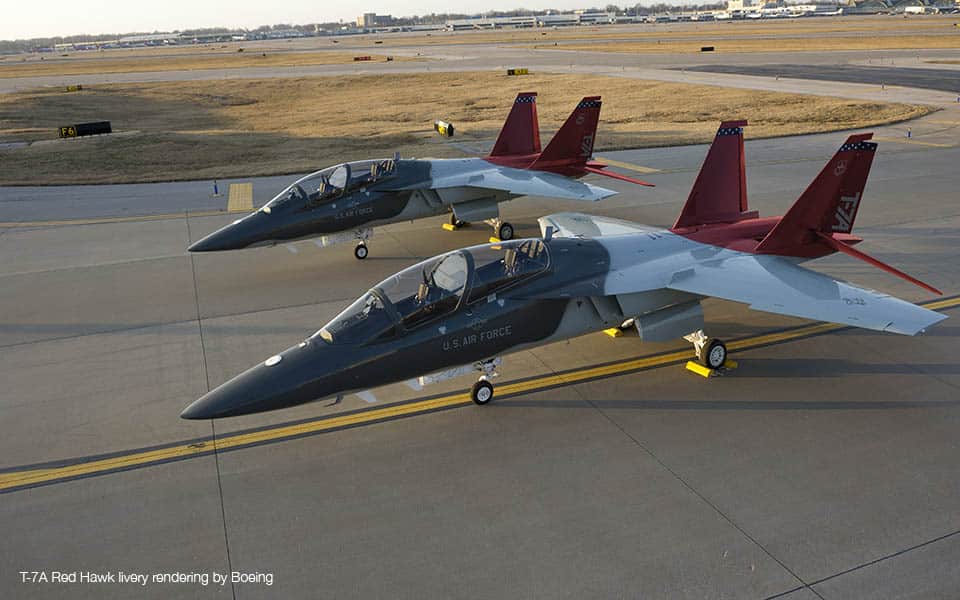
Boeing T-X Marketing Shots with 2 planes and 2 pilots at Sunrise Lambert Airport Ramp_MSF17-0004 Series_2/5/2017_RMS#306154
- The GE F404 engine powers it.
Boeing’s T-X is a single-engine advanced jet trainer with a twin tail, tandem seating, and retractable tricycle landing gear developed by Saab, a Swedish aerospace partner. A General Electric F404 afterburning turbofan engine powered the aircraft and display versions.
- For rapid development, use the digital engineering process.
To facilitate more rapid and economical future aircraft development, the aircraft was built using digital engineering procedures, agile software development, and an open architecture mission system. These cutting-edge, computer-assisted manufacturing processes support the US Air Force’s Digital Century Series plan while also expanding the supplier base.
Boeing Begins Build on New Zealand’s First P-8A Aircraft
- This plane was built in just three years.
As a result of defying the rules, this aircraft was created in under three years from idea to first flight. This demonstrates how technology can assist in obtaining quick results. This aircraft would be appropriate for maintainers, offering extremely immersive training and skill transfer, as well as advanced fighter-like performance qualities comparable to today’s 4th and 5th-generation fighters.
- It has the ability to upgrade to a fighter variant.
The T7 aircraft, according to Boeing, can be customised to the pilot’s preferences. Software can be simply adjusted to meet future needs. Rather of using the most expensive training methods, the T7 can meet the requirements of the Air Force and train students in less time.
First A380 powered by 100% Sustainable Aviation Fuel takes to the skies
The T-7A’s architecture allows for expansion should new tasks, such as an aggressive, light attack / fighter variant, become available. This aircraft is simple to maintain, and Saab has created new software for the T-7 to aid in development costs and speed. Splicing the aft segment with the wings takes only 30 minutes on the T-7A’s sophisticated and digital production line.
- A single plane can cost up to $19.3 million in the United States.
The Boeing design was officially announced as the US air force new advanced jet trainer to replace the T-38 Talon on September 27, 2018. At a cost of up to US$9.2 billion, a total of 351 aircraft, 46 simulators, maintenance training, and support will be provided. All 475 planes were purchased for $19.3 million each unit.
Boeing plans to sell approximately 2,700 Red Hawks around the world. The business is eyeing Serbia and Australia as prospective overseas customers in addition to the US Air Force.

Aerospace
Boeing Transfers Rocket Stage to NASA, Paving Way for Human Moon Mission

Boeing has achieved a significant milestone by providing NASA with the second core stage of the Space Launch System (SLS) rocket.
This crucial component, crafted at NASA’s Michoud Assembly Facility (MAF), is set to propel the Artemis II crew into lunar orbit, marking humanity’s return to deep space after a 50-year hiatus.
The monumental Boeing-built rocket stage, the largest element of the Artemis II mission, will embark on a journey aboard the Pegasus barge, traveling 900 miles to NASA’s Kennedy Space Center.
Comparison of two legendary aircraft B777x vs B747 aircraft:Click here
Upon arrival, it will be meticulously integrated with other essential Artemis II components, including the upper stage, solid rocket boosters, and NASA’s Orion spacecraft within the iconic Vehicle Assembly Building. This intricate integration process is a vital step toward the eagerly anticipated Artemis II launch, slated for 2025.
“Boeing-built products helped land humankind on the moon in 1969, and we’re proud to continue that legacy through the Artemis generation,” remarked Dave Dutcher, vice president and program manager for Boeing’s SLS program. “Together, with NASA and our industry partners and suppliers, we are building the world’s most capable rocket and paving the way to deep space through America’s rocket factory in New Orleans.”
NASA, Lockheed Martin Reveal X-59 Quiet Supersonic Aircraft:Click here
The delivery of Core Stage 2 marks a significant achievement in the evolution of the SLS rocket. Towering over 200 feet and powered by four RS-25 engines, this core stage, coupled with two solid-fueled booster rockets, will generate a staggering 8.8 million pounds of thrust. This immense power is crucial to launching Artemis II and future missions into the vast expanse of space.
The SLS rocket stands unparalleled in its capability to transport both crew and substantial cargo to the moon and beyond in a single launch. Its extraordinary capacity will facilitate the delivery of human-rated spacecraft, habitats, and scientific missions to destinations including the moon and Mars, ushering in a new era of space exploration.
-

 Travel1 week ago
Travel1 week agoAir India to Expand US Operations with Three New Routes After a Decade
-

 Travel2 weeks ago
Travel2 weeks agoWhy We Should Avoid These Stamps in a Passport
-

 Airlines1 month ago
Airlines1 month agoInvestigations Reveal Fake Chinese Titanium in Boeing and Airbus Jets
-

 Tech4 weeks ago
Tech4 weeks agoChina’s CATL Plans 1,800-Mile Electric Plane Launch by 2027
-

 Airport3 days ago
Airport3 days agoTop 10 Largest Airports in the World by Size
-

 Aerospace4 weeks ago
Aerospace4 weeks agoChina’s Fighter Jets Turn Wings into Autonomous Drones
-

 Airlines4 days ago
Airlines4 days agoAir India Rolls Out A350s for Delhi-New York JFK and Newark Routes
-

 Defence3 weeks ago
Defence3 weeks agoBoeing Enhances Chinook with New Engines and Block II Upgrades at $96 Million


